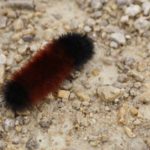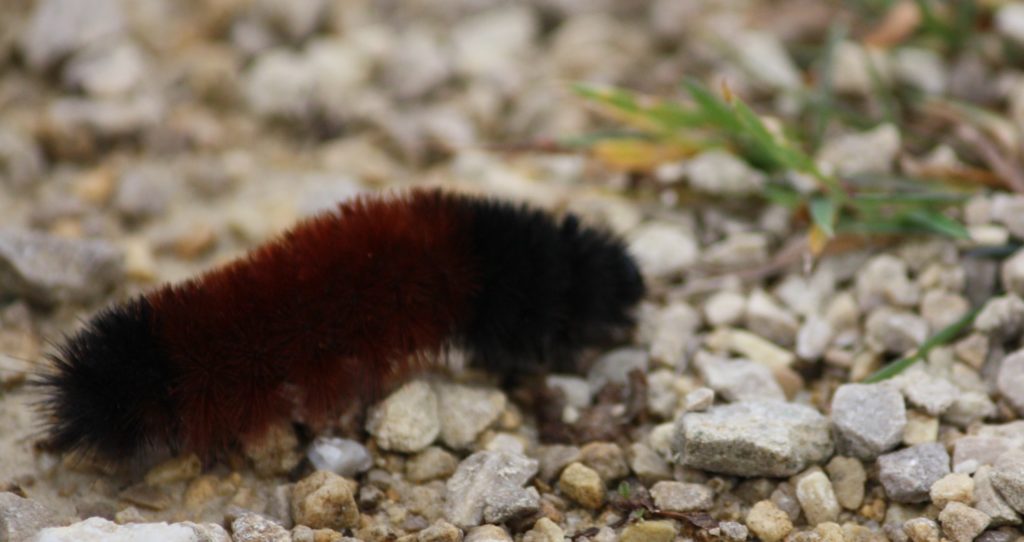 Wooly bears are on the march. Whether on sidewalks or on trails, you can hardly walk anywhere these days without crossing the path of this favorite fuzzy caterpillar.
Wooly bears are on the march. Whether on sidewalks or on trails, you can hardly walk anywhere these days without crossing the path of this favorite fuzzy caterpillar.
There’s something about seeing a wooly bear – so seemingly intent on its destination – that always makes me smile. But sometimes I feel vaguely troubled, too, because I am reminded of the countless mysteries in life that I ponder but never get around to looking up. Mysteries like: Does a blacker wooly bear really foretell a harsh winter? Or is it a browner wooly bear that does that? And how is it even possible for a caterpillar to forecast the weather?
And what the heck is a wooly bear, anyway?
Questions like these always come to me when I’m outside, far from the field guides on the bookshelf. Far from my laptop and the all-answering internet. Smart phone in the car. I jot my questions in my notebook, continue my walk…and forget.
And thus do countless questions about the natural world pile up over the years. Until today. Today, while working in the garage, I found a wooly bear behind the car. I scooped it up to move it to the relative safety of the front yard, and as it curled up in self-defense, I felt the bristly ball roll in my palm and remembered the wonder that I felt as a child the first time I held a wooly bear in my hand.
I went right inside the house and typed “wooly bear” into my computer’s search engine. Eureka.
It took just seconds for me to learn that the banded wooly bear (just one of several types of wooly bear) is the larva – the caterpillar – of the Isabella tiger moth. And if Isabella tiger moths – presumably as numerous as wooly bears – had in the past escaped my notice, it is perhaps because these nocturnal creatures are as nondescript as a soiled scrap of paper.
The wooly bears we see in October have been growing throughout the summer, munching on maple leaves, clover, sunflowers, and various other plants. They’ve molted, or shed their fuzzy hides, as they passed through a series of growth phases, called “instars.” The black-and-brown bands change, not with the weather forecast, but with successive molts.
Now, as food sources dwindle, the caterpillars are searching for winter shelter, under a log or tree root, perhaps, where their bodies cool in accord with the world around them, essentially freezing until warm weather returns. Come spring, the caterpillar thaws and spins a pupa – incorporating its wooly-bear fuzz – and, as if its life to this point were not miraculous enough, the body inside the pupa will be re-made into a thing with wings – a moth! The moth flies off in search of a mate; the female lays eggs on a plant that will provide food for the larvae when they hatch, and the cycle begins again.
All this I waited half my life to learn. I should stand on my roof and shout the news.
The news, however, is not just about wooly bears. It’s this: While much about nature remains unknown to science, a wealth of knowledge – more than we can imagine – is at our fingertips. We only need to reach for it. The next time I jot a question in my notebook while walking, I’ll stow that question in a different pocket – a reminder to look it up when I get home.
What “abiding mysteries” have you wondered about for years? Resolve that the next time you think of one, you’ll drop everything and run to the nearest search engine. You might be surprised by what you learn – and by how satisfying it is to solve a years-old puzzle.
After all, when we no longer need to wonder about an “abiding mystery” like wooly bears, we have more time, and more reason, to wonder at the earth’s marvels.
Sources:
Butterflies and Moths of North America. www.butterfliesandmoths.org
Covell, Charles V. Jr., A Field Guide to Moths: Eastern North America. The Peterson Field Guide Series. Boston: Houghton, 1984.
NOAA, “Wooly Bear Caterpillar – Winter Predictor or Not?” https:/www.weather.gov/arx/woolybear
Triplehorn, Charles A. and Norman F. Johnson. Borror and DeLong’s Introduction to the Study of Insects. 7th ed. Belmont, CA: Brooks/Cole, 2005.

